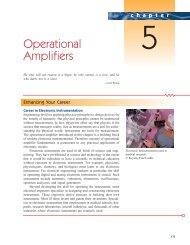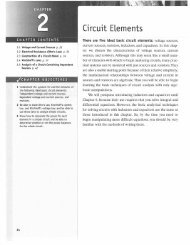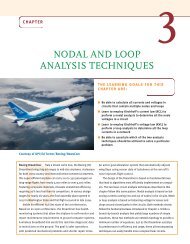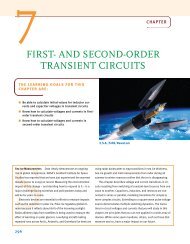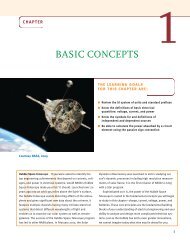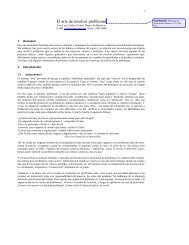Fundamentals of Electric Circuits
Fundamentals of Electric Circuits
Fundamentals of Electric Circuits
Create successful ePaper yourself
Turn your PDF publications into a flip-book with our unique Google optimized e-Paper software.
3.4 Mesh Analysis 93<br />
Find v 1 , v 2 , and in the circuit <strong>of</strong> Fig. 3.14 using nodal analysis.<br />
v 3<br />
Answer: v 1 3.043 V, v 2 6.956 V, v 3 0.6522 V.<br />
Practice Problem 3.4<br />
6 Ω<br />
10 V<br />
v v 5i<br />
2<br />
1 + −<br />
v 3<br />
i<br />
+ −<br />
3.4<br />
Mesh Analysis<br />
Mesh analysis provides another general procedure for analyzing circuits,<br />
using mesh currents as the circuit variables. Using mesh currents<br />
instead <strong>of</strong> element currents as circuit variables is convenient and<br />
reduces the number <strong>of</strong> equations that must be solved simultaneously.<br />
Recall that a loop is a closed path with no node passed more than once.<br />
A mesh is a loop that does not contain any other loop within it.<br />
Nodal analysis applies KCL to find unknown voltages in a given<br />
circuit, while mesh analysis applies KVL to find unknown currents.<br />
Mesh analysis is not quite as general as nodal analysis because it is<br />
only applicable to a circuit that is planar. A planar circuit is one that<br />
can be drawn in a plane with no branches crossing one another; otherwise<br />
it is nonplanar. A circuit may have crossing branches and still<br />
be planar if it can be redrawn such that it has no crossing branches.<br />
For example, the circuit in Fig. 3.15(a) has two crossing branches, but<br />
it can be redrawn as in Fig. 3.15(b). Hence, the circuit in Fig. 3.15(a)<br />
is planar. However, the circuit in Fig. 3.16 is nonplanar, because there<br />
is no way to redraw it and avoid the branches crossing. Nonplanar circuits<br />
can be handled using nodal analysis, but they will not be considered<br />
in this text.<br />
2 Ω 4 Ω 3 Ω<br />
Figure 3.14<br />
For Practice Prob. 3.4.<br />
Mesh analysis is also known as loop<br />
analysis or the mesh-current method.<br />
1 Ω<br />
1 A<br />
2 Ω<br />
5 Ω 6 Ω<br />
4 Ω<br />
3 Ω<br />
8 Ω<br />
7 Ω<br />
1 Ω<br />
(a)<br />
5 Ω<br />
6 Ω<br />
4 Ω<br />
3 Ω<br />
7 Ω<br />
2 Ω<br />
1 A<br />
2 Ω<br />
13 Ω<br />
5 A<br />
12 Ω<br />
11 Ω<br />
9 Ω<br />
8 Ω<br />
5 Ω<br />
1 Ω 3 Ω<br />
4 Ω<br />
6 Ω<br />
Figure 3.16<br />
A nonplanar circuit.<br />
10 Ω<br />
To understand mesh analysis, we should first explain more about<br />
what we mean by a mesh.<br />
8 Ω 7 Ω<br />
(b)<br />
Figure 3.15<br />
(a) A planar circuit with crossing branches,<br />
(b) the same circuit redrawn with no crossing<br />
branches.<br />
A mesh is a loop which does not contain any other loops within it.




